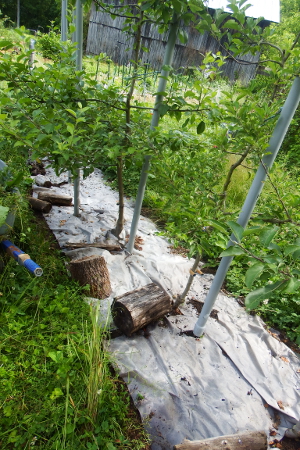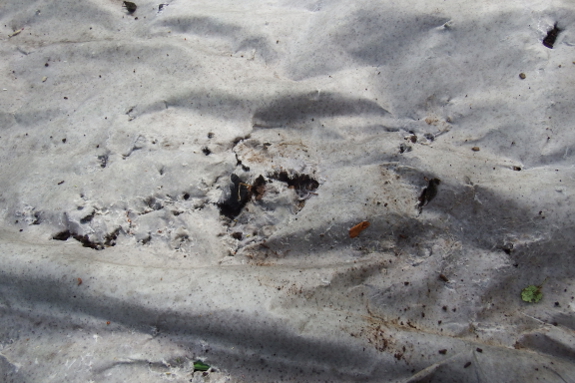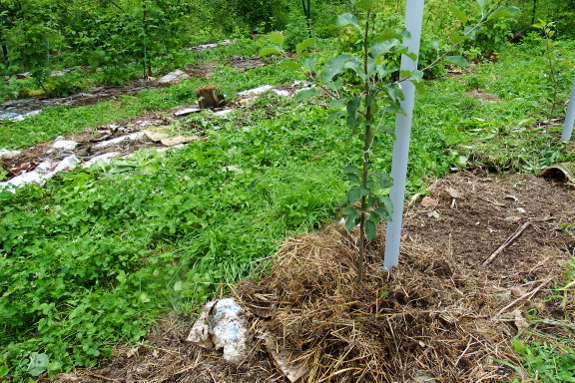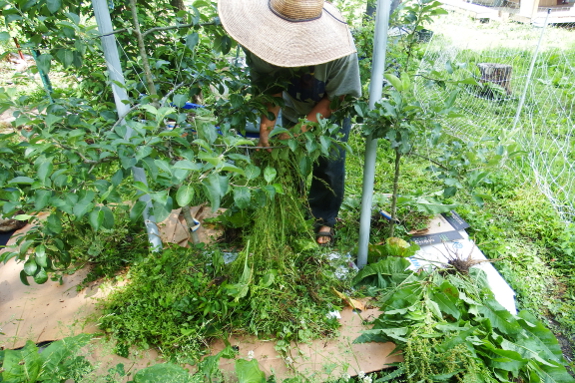
Two methods for mulching perennials
 A
couple of our experiments this spring have focused on trying out new
methods of mulching around our perennials, and I thought it was time to
give you an update on my successes and failures. I've never been
entirely pleased with my mulch campaign in our berry and high-density
tree rows because I never have enough of my favorite mulch --- rotted wood chips --- to go around. For the last couple of years, I've instead mulched these guys with bedding from our chicken coops, but that material rots down pretty fast, is really too nitrogen-rich for woody perennials, and would be better used in the vegetable garden. Time to try something new!
A
couple of our experiments this spring have focused on trying out new
methods of mulching around our perennials, and I thought it was time to
give you an update on my successes and failures. I've never been
entirely pleased with my mulch campaign in our berry and high-density
tree rows because I never have enough of my favorite mulch --- rotted wood chips --- to go around. For the last couple of years, I've instead mulched these guys with bedding from our chicken coops, but that material rots down pretty fast, is really too nitrogen-rich for woody perennials, and would be better used in the vegetable garden. Time to try something new!

First of all, the roll of paper mulch we tried around our high-density apples
has now been marked down as an official failure. Don't get me wrong ---
the paper held back weeds very well (as long as the beds started out
weed free). But the paper only lasted about six weeks before it
developed big holes, even where no pets walked across the garden beds.
With a price tag equivalent to covering this area with a healthy layer
of straw (a mulch that would have lasted much longer while adding a lot
more organic matter to the soil), I don't think we'll be trying rolls of
paper again.

On the other hand, I'm
falling more and more in love with using plain old flattened cardboard
boxes around our woody perennials. I'd never laid down cardboard with
nothing on top before, so I've been surprised by how well the cardboard
stands up to the weather while also making the soil underneath loose,
damp, and happy. For example, the apple row in the foreground of the
photo above was treated to a layer of cardboard last fall, which has
since rotted enough that I had to double up the layers around the fruit
trees. But that left happy, bare soil behind where tree roots haven't
yet colonized the soil, so I scattered on some buckwheat and I suspect
we'll be good to go for quite a while. One layer of cardboard lasting
perhaps all year is a pretty good deal!

The straw-like substance
on top of the cardboard in my previous photo is simply garden weeds that
I had piled up nearby. Cardboard does
require some sort of object on top to weigh it down, so my new method
involves a quick weed of the biggest plants in the area I'm planning to
mulch with cardboard, followed by a layer of cardboard topped off with a
sprinkling of the weeds just pulled. The cardboard barrier prevents
weed roots from recolonizing the soil, and the dying weeds hold the
cardboard down until it melds with the soil. Just don't do this with
creeping plants (certain grasses, ground ivy, etc.), or you'll end up
with a weed problem on top of your mulch.
I suspect my slapdash cardboard mulches wouldn't fly in a city garden.
But if you live out in the country (and have a city person to collect
cardboard boxes from the side of the road for you --- thanks, Mom!), I
highly recommend that you give this perennial mulching option a shot.
Want more in-depth information? Browse through our books.
Or explore more posts by date or by subject.
About us: Anna Hess and Mark Hamilton spent over a decade living self-sufficiently in the mountains of Virginia before moving north to start over from scratch in the foothills of Ohio. They've experimented with permaculture, no-till gardening, trailersteading, home-based microbusinesses and much more, writing about their adventures in both blogs and books.
Want to be notified when new comments are posted on this page? Click on the RSS button after you add a comment to subscribe to the comment feed, or simply check the box beside "email replies to me" while writing your comment.
